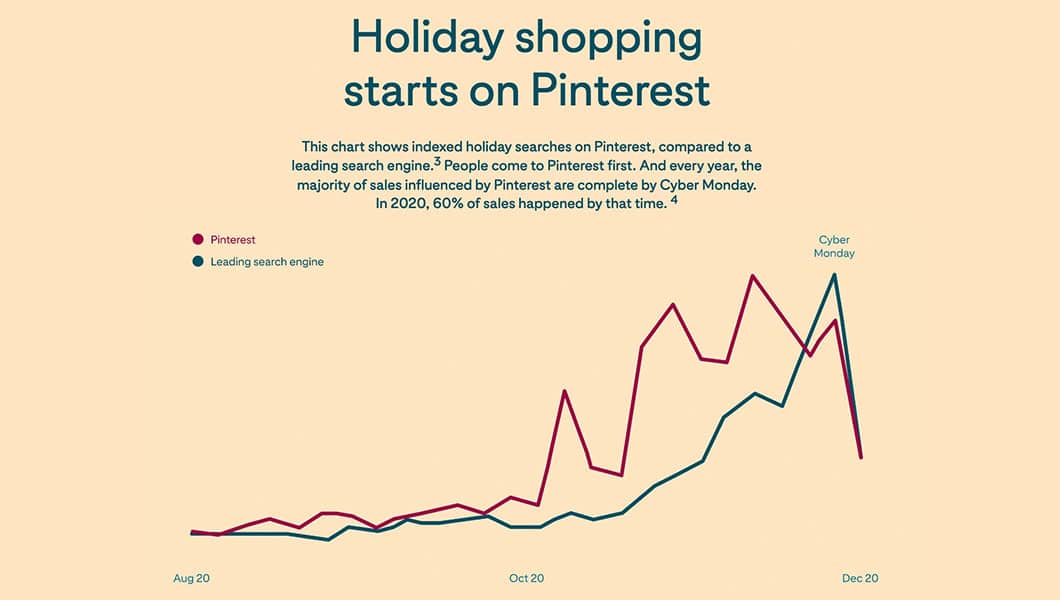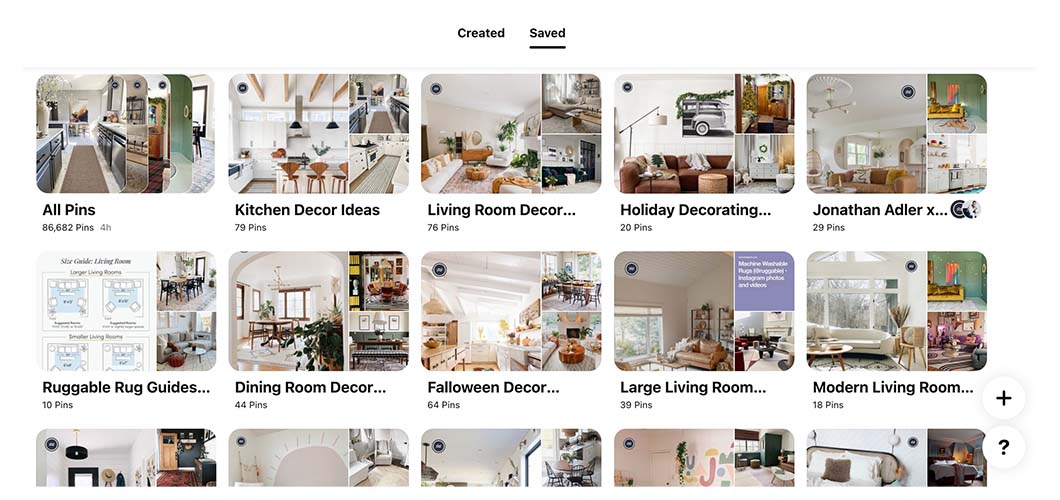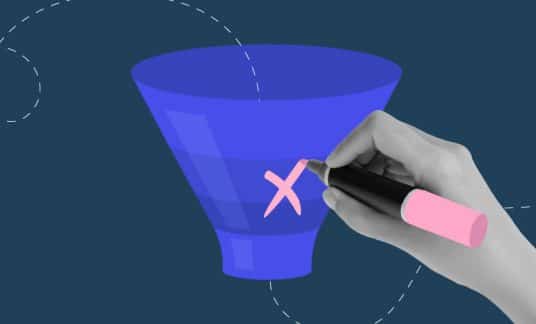Pinterest often flies under the radar, especially for small businesses. But it’s actually one of the most popular social networks in the world with 454 million active users, according to Statista. If you use Pinterest, a marketing strategy is in order.
More than that, people use Pinterest to shop and discover new ideas. According to Pinterest Business, 80% of weekly users have found a new brand or product on the network.
But how do you make your business stand out among the casserole recipes? There are definitely do’s and don’ts to follow for success in Pinterest marketing.
Here are 10 tips for using Pinterest for business the right way.
Why Should You Use Pinterest for Business?
Besides using Pinterest to find new ideas and products year-round, consumers frequent the platform in preparation for the holiday season. According to data from Pinterest, more holiday-themed product searches happen on the social media network versus the leading search engine every year.

Facebook is often touted as the gold standard for global business advertising, but Pinterest holds its weight with an estimated reach of more than 200 million people, according to data from Hootsuite.

OK, so we’ve got search intent and a potential audience. But what else makes Pinterest special for brands?
The 3 main benefits of using Pinterest for your business are:
1. It’s a Visual Search Engine
At first glance, Pinterest looks more like a scrapbook than the first page of Google search results. But Pinterest is actually, fundamentally, a search engine.
Similar to Google and other search engines, Pinterest:
- Prioritizes search results based on keyword usage in descriptive text, titles and uniform resource locators (URLs).
- Prioritizes search results based on ad targeting metrics and user history.
- Helps your website domain authority by providing backlinks to your content.
And like a search engine, Pinterest is an excellent way of generating organic website traffic.
2. Content With an Educational Focus
People use Pinterest to learn things. About 85% of users begin with a Pinterest search when they’re starting a new project, according to Pinterest. And, 97% of all searches aren’t branded — which means users aren’t searching for specific brand or product names.
That means the content that succeeds most often on Pinterest is educational and informative in nature, instead of promotional.
Instead of focusing messaging around a big sale you’re having, you should create content around what your product can do. For example, instead of promoting a particular product, furniture retailer Article created a pin about setting a Thanksgiving table.

Note the lack of obvious Article branding in the visuals. This is intentional because the focus is on education, not selling. That happens later, naturally.
3. A Focus on Conversions
An educational focus works. Pinterest is a conversion machine.
Consider these powerful Pinterest statistics:
- Pinterest users, or pinners, spend 80% more on shopping every month compared with nonpinners, according to Pinterest.
- Pinners are 3 times more likely to click a Pinterest link than on any other social network, according to Highspot.
- 44% more pinners are engaging with shopping features year over year, according to Pinterest.
- Combining free shopping tools with ads yields 3 times the conversions, according to Pinterest.
So, let’s make you some money. Here’s how to effectively market your business on Pinterest:
How to Build a Successful Pinterest Marketing Strategy: 5 Steps
1. Get a Pinterest Business Account
Creating a Pinterest business account is free. You should get a business account, instead of a personal one, so you can view analytics and place ads. Even if you don’t plan on advertising right now, it’s still a good idea to sign up for a business account for the extra insights.
Other benefits to a business account include:
- Custom branded header image.
- Verified website URL.
Access to special pin types, such as Try-On Pins (a virtual fitting room functionality).

2. Use an Original Visual Style
Visuals are the key to Pinterest.
Creating original, high-quality images and video should be at the center of your Pinterest marketing strategy. It’s important to have stylized, but natural looking, content that isn’t explicitly branded, but also has a cohesive brand style people can learn to expect from you.
Piece of cake, right?
Great visual branding isn’t easy, but it can evolve with time. Check out Ruggable, which takes advantage of a custom video header that draws you in right away.

Here, Ruggable sticks to a calm, neutral color palette for the rest of their pins and boards. It’s comfortable and relaxing.

A strong visual brand makes customers feel a certain way when they see it. Here’s an example of a very different feeling than calm, neutral Ruggable. Benefit Cosmetics’ profile uses bold color to grab attention and provide an energizing atmosphere.

Along with your visual style, ensure your pins aren’t overly sales-focused. Show your product in creative ways, such as the fun layouts Benefit has above. Or, show your product in a real life situation.
Herschel does this well with its luggage. The company could have shown a bag on a white background, such as you see on their ecommerce site.

But, knowing Pinterest is a visual-heavy platform, Herschel realized it needed something more eye-catching to draw in leads. The company does include simple product shots, but the majority of their content is editorial and designed to convey a sense of urban, upscale adventure.

When in doubt, ask yourself, “Are my pins reflective of what my brand would look like in a magazine?”
3. Optimize for Keywords
The same strategies you use for ranking in organic search results in Google apply to Pinterest, too.
Instead of optimizing for the same keywords you do for your website, find your Pinterest counterparts. For example, people may search for “modern furniture near me” on Google, but use “midcentury modern inspiration” on Pinterest. Typing in your product or a topic will show you related popular search terms.

The key areas to use Pinterest search engine optimization (SEO) keywords are:
- Your profile description
- Pin title
- Pin description
- Board names
This pin ranks highly for the popular search term “home decor ideas.” It’s heavily optimized for terms related to decor, including “farmhouse decor.”

Besides advertising, optimizing your organic Pinterest SEO is the best thing you can do to maximize your reach.
4. Use Rich Pins
Rich pins are the Cadillacs of Pinterest content. In short, they contain extra information that gets automatically pulled from your website.
There are 4 types of rich pins:
- Articles
- Apps
- Products
- Recipes
For example, here’s a recipe pin that isn’t a rich pin:

And here’s one that is:

Similarly, product pins include a direct link to shop and article pins feature the author’s name.
Setting up rich pins is simple. You need to add a bit of code to your site, validate it with Pinterest and you’re good to go.
5. Engage With Others
As with all social networks, engagement is a two-way street. How will anyone discover your profile or pins if you exist in a bubble?
On at least a weekly basis, make sure to:
- Comment on other pins
- Pin to group boards for added exposure
- Add others’ pins to your boards
- Follow others
- Pin to your own boards
- Repin your own content so it’s fresh again
5 Tips to Take Your Pinterest Marketing to The Next Level
1. Use Storytelling
Marketers know storytelling drives conversions. Research from Headstream found 55% of consumers are more likely to buy something later if they see a story about it and 15% buy it right away.
To tell a story on Pinterest, don’t have boards of entirely your own content. Mix it up. Feature your latest products along with other pins that work together with your theme.
Yogurt brand Chobani does this well. Here, the company has mixed its own pins in with recipes from other websites on a board titled “Flavor Inspiration.”

2. Change Up Your Pin Type
We covered rich pins above, but Pinterest offers many different pin formats. Some are only available to business accounts, so that’s another reason you’ll be glad you made one.
In 2021, Pinterest launched idea pins, which are short videos focused on how to or inspirational content. This new format is still launching worldwide, but gaining popularity quickly.

In addition to this exciting new format, and the standard vertical image pins, you can create:
- Video pins
- Carousel pins
- Shoppable/product pins
- Sections within a board
- Collection pins
- Sponsored content
- Try-on pins
- Article pins
- Recipe pins
- App pins
3. Track Your Analytics
Business accounts have access to analytics so make the most of it.
Check your analytics at least monthly, paying attention to 3 main areas:
- Your audience metrics and growth
- Conversion tracking on your campaigns
- Current trends to see what people are searching for on Pinterest right now to inform future content

4. Try Pinterest Ads
Most businesses could benefit from Pinterest advertising, especially ecommerce. Pinterest reports that its ads have 2.3 times more efficient cost per conversion than other social networks.
Great visuals are important for your organic content and even more important for your paid ads.
Now’s the time to invest in professionally shot photos or even a short video about your product or company. Put together a campaign of image ads, video ads, shoppable pins and more.
As the old saying goes, “Don’t put all your content eggs in one basket.”
5. Schedule Content in Advance
This applies to all your social marketing. Scheduling your content in advance helps you stay consistent as well as cover times of day you aren’t available to post live. And, of course, this saves time by batching your Pinterest efforts into one session versus having to remember to post daily.
Most social media schedulers nowadays can schedule to Pinterest, though popular options are Later or Planoly. Additionally, with a business account, you can schedule pins directly on the Pinterest website.
Inspire Your Audience to Action with Pinterest for Business
Once thought of as only a place for recipes and do-it-yourself projects, Pinterest has grown to become a profitable social platform for businesses too.
Pinterest’s power lies in it being the go-to place consumers go to learn something new or discover a new product. Thanks to advancements by Pinterest, it’s easier than ever for brands to capitalize on that with shoppable pins, idea pins, promoted pins, sponsored content and more.
If you’ve wondered how to use Pinterest for marketing, there’s no better time than now to make it part of your overall social media strategy.












